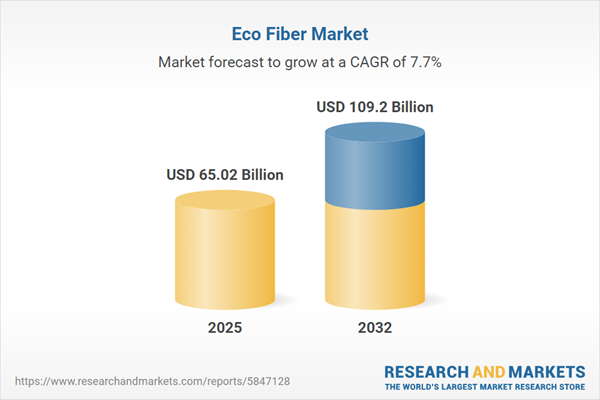Speak directly to the analyst to clarify any post sales queries you may have.
Senior decision-makers are embracing the eco fiber market as a core strategy for advancing sustainable procurement and building resilient supply chains. Growing regulatory attention and evolving industry benchmarks are positioning eco fibers as essential enablers of supply chain compliance and innovation across diverse sectors.
Eco Fiber Market Snapshot
The eco fiber market is experiencing sustained growth as executives across industries respond to progressively stringent procurement standards and new sustainability imperatives. Historically rooted in textiles, the eco fiber landscape has rapidly expanded its influence to applications in automotive, construction, and industrial sectors. Advances in material science, combined with policy incentives, are accelerating the adoption of eco fibers. The integration of digital traceability technologies is further strengthening compliance oversight and supporting transparent supplier coordination. Collectively, these shifts are empowering organizations to elevate operational agility and define new benchmarks for responsible sourcing in changing market conditions.
Scope & Segmentation of the Eco Fiber Market
This report delivers actionable segmentation and analysis for procurement and supply chain leaders seeking clear insights into the eco fiber sector. Executive-focused research supports informed strategic sourcing, risk controls, and sustainable decision-making.
- Fiber Types: Coverage includes acrylic, nylon, polyester, polypropylene, and regenerated cellulosic fibers. Analysis focuses on their technical attributes, adaptability to multiple industrial applications, and their impact on sourcing strategies.
- End Uses: Evaluates sectors such as apparel (activewear, formalwear, specialty textiles), automotive interiors, construction materials, industrial filtration, belting, and healthcare products, linking fiber characteristics with precise application needs.
- Product Forms: Reviews filament and staple fibers, highlighting process efficiencies and their suitability for well-established as well as emergent industry segments.
- Source Origins: Compares bamboo, corn, polylactic acid, recycled nylon, recycled PET, and petroleum-based sources, weighing procurement benefits, environmental profiles, and cost dynamics to support strategic sourcing.
- Geographical Regions: Analyzes the Americas, Europe, Middle East and Africa, and Asia-Pacific, assessing how each region’s policies and evolving consumer preferences affect supplier selection and compliance management.
- Company Coverage: Profiles leading players, including Lenzing Aktiengesellschaft, Sateri Holdings Limited, Grasim Industries Limited, Toray Industries, Unifi, Wellman International, and Kolon Industries. Each profile details contributions to market development and progress in sustainable sourcing initiatives.
Eco Fiber Market: Key Takeaways for Decision-Makers
- Standardized procurement is increasing transparency, enabling organizations to respond effectively to new and complex eco fiber market requirements.
- Innovative material developments are supporting adoption in technical settings where regulatory compliance and durability are key, creating new options for procurement teams.
- Digital tools such as smart sensor monitoring deliver end-to-end traceability, contributing directly to environmental and sustainability objectives.
- Flexible sourcing strategies that reflect differing regional policy frameworks help organizations adjust rapidly to changing compliance and customer demands.
- Collaboration between well-established suppliers and emerging companies is expanding the range of solutions, making it possible to customize procurement for industries with specialized or evolving requirements.
Tariff Impact: Navigating 2025 United States Policy Shifts
Upcoming changes to U.S. tariffs are leading executives to review eco fiber sourcing strategies. Companies are diversifying supplier networks, strengthening relationships with proximate vendors, and restructuring their operational models to anticipate potential disruptions. Initiatives such as nearshoring, deeper vertical integration, and long-term supply commitments are prioritized for ongoing compliance and risk management. Early planning is essential to address tariff-driven risks and maintain operational continuity.
Methodology & Data Sources
This report’s findings are based on executive interviews, peer-reviewed research, regulatory assessments, and the latest manufacturing data. The combination of these sources produces practical, timely insights for procurement and supply chain leaders focused on the eco fiber market.
Why This Report Matters
- Enables executives to reinforce risk controls and adapt sourcing strategies as the eco fiber sector undergoes continued transformation.
- Delivers targeted guidance for implementing advanced materials, adopting digital traceability, and staying aligned with new compliance expectations in core industries.
- Demonstrates how cross-industry collaboration is contributing to procurement frameworks that support sustainability and operational flexibility in evolving markets.
Conclusion
As eco fiber adoption accelerates, this report empowers organizations to align procurement practices with emerging sustainability and compliance requirements, supporting effective decision-making amid rapid market transition.
Additional Product Information:
- Purchase of this report includes 1 year online access with quarterly updates.
- This report can be updated on request. Please contact our Customer Experience team using the Ask a Question widget on our website.
Table of Contents
3. Executive Summary
4. Market Overview
7. Cumulative Impact of Artificial Intelligence 2025
Companies Mentioned
The companies profiled in this Eco Fiber market report include:- Lenzing Aktiengesellschaft
- Sateri Holdings Limited
- Grasim Industries Limited
- Toray Industries, Inc.
- Unifi, Inc.
- Wellman International Limited
- Kolon Industries, Inc.
Table Information
| Report Attribute | Details |
|---|---|
| No. of Pages | 197 |
| Published | October 2025 |
| Forecast Period | 2025 - 2032 |
| Estimated Market Value ( USD | $ 65.02 Billion |
| Forecasted Market Value ( USD | $ 109.2 Billion |
| Compound Annual Growth Rate | 7.7% |
| Regions Covered | Global |
| No. of Companies Mentioned | 8 |









